
|   |

|   |
Natyanjali’s Natya Utsav Text & pics: Lalitha Venkat e-mail: lalvenkat@yahoo.com October 23, 2013 Instead of hosting her usual Nartaka Festival in October, Prema Satish of Natyanjali Trust surprised us by presenting a ‘Bharatanatyam festival for young dancers of merit’ titled Natyanjali’s Natya Utsav, from October 18 – 20, 2013 at the still being renovated Bharatiya Vidya Bhavan, Chennai. The festival got off to a good start with vibrant performances by Dakshina Vaidyanathan from Delhi and Punyah Dance Company from Bangalore. 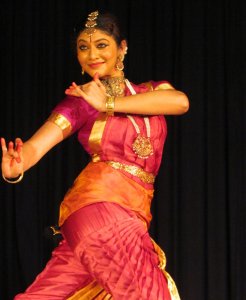 Dakshina Vaidyanathan
Daughter of Rama Vaidyanathan, one of the most versatile Bharatanatyam dancers today, the rasikas had great expectations from Dakshina and she did not disappoint. Dakshina commenced with two pure dance items, Pushpanjali composed by Lalgudi Sri Ganesh and Alarippu composed by Karaikudi Krishnamurthy. The main item, the varnam “Viriboni” of Pacchimiriam Adiyappa in Bhairavi ragam, ata thalam, had been performed earlier by Rama Vaidyanathan for Natyanjali Trust at this same venue and here was Dakshina presenting the same after 10 years! In this item, the sakhi gives the heroine’s message to her lord Krishna, using the metaphor of a flower. All the jathis were by Karaikudi Krishnamurthy and rhythmic patterns by Karaikudi Sivakumar. The pretty lotus was depicted in many enchanting gestures, Dakshina’s costume itself being in lotus pink and gold. It was an energetic varnam with not many restful poses or pauses. Depicting Yashoda’s love for Krishna, Dakshina emoted the mother sentiment in “Enna thavam seithanai” of Papanasam Sivan, how Yashoda considers it her good fortune to be called ‘mother’ by the divine child. Dakshina depicted all the emotions suitably and managed to still look pleasant throughout. The thillana in ragam Varamu to lyrics by Subramanya Bharati and music by GS Rajan was followed by Ardhanareeswara Stotram of Adi Shankara. In movement and facial expression, the dancer brilliantly alternated between lasya and tandava aspects with utmost ease. It was also interesting that she did not freeze into poses every now and then through the recital and maintained a high level of energy, covering the stage space well and executing movements with precision. All the items presented were choreographed by Rama and watching Dakshina perform was like seeing a younger version of Rama, she was so much in sync with her mother’s style. Lalgudi Sri Ganesh on mridangam, K Venkateswaran on vocal and Biju Sivanand on violin provided wonderful support to the young dancer. Busy artiste that she is with such a hectic schedule, it was a change to see Rama as part of the music ensemble belting out the jathis. The lighting could have been at least a little bit artistic instead of being flat throughout. The festival was then inaugurated by Malavika Sarukkai who confessed to not accepting such invitations in general. In her brief speech, she said, “The young dancers who are going to continue the tradition and take the art forward need a platform. Mothers and daughters have a special bond. One can see that in Prema having her mother’s photo on stage, the bond between Rama and Dakshina through the recital. It is good to see dancers training their body and mind and not just present a pretty program. Rama’s choreography is different to see on her body, but it has a separate kind of energy on Dakshina’s body. The music was devoid of any gimmicks, something rare to experience these days where there is more noise, so we end up being more flustered than feeling soukyam from the music.” The hammering noise somewhere in the background was located and the workmen asked to stop! 

Punyah Dance Company from Bangalore headed by Parshwanath Upadhye presented a high voltage story of ‘Punyah Krishna’ replete with leaps and jumps and some interesting group formations. This journey of a bhakta was performed to recorded music of select verses of Shankaracharya's Krishnashtakam and showed episodes from Krishna’s childhood like his many pranks, the nicely choreographed Kaliya mardana, Poothana episode, dalliance with the gopis and so on. The music was composed by G. Shrikant from Chennai. Choreographer Parshwanath says, “Though the format of the presentation was close to varnam’s first half, swarams were played only in the instruments and not in vocal as the typical nritta was not performed to the swarams. I had also used few of the charis like Vidyukt Branta and Mattalli to add to the beauty of the presentation.” As the central character, Parshwanath was ably supported by female dancers Preeti Bharadwaj, Surabhi Bharadwaj, Mathangi Prasan and Sneha Devanandan, all sporting a small kondai Andal style on the left side of the head. “Andal kondai was a part of aesthetic enrichment. As all of us are Krishna devotees, I couldn’t think of anything else other than Andal kondai, as Andal is synonymous with Krishna bhakti,” says Parshwanath. It was a well coordinated group and the lively rendering with flexible movements was a treat to watch. The group concluded with a brisk thillana in Jhonpuri and adi tala composed by Kartik Hebbar. The sahityam was on Lord Vrishabanatha, the first Theertankara of Jainism whom many scholars consider as Lord Shiva himself. 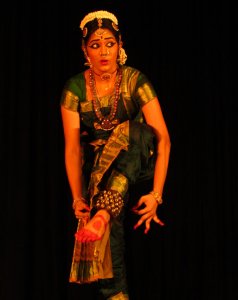 Amritavarshini
It was mixed fare on day two. With so many dance programs happening at various venues including Alarmel Valli’s ‘Baani’ and Natyarangam program, the rasikas had to spread themselves across various venues, some even planning for some venue hopping. It was thus a pleasant surprise to see a packed hall, thanks to the presence of families of the dancers to perform. M Amritavarshini, disciple of Urmila Sathyanarayanan, commenced the evening with a solo recital. She presented Pushpanjali composed by Swamimalai SK Suresh, varnam “Mamohalagiri” in Khamas ragam, “Yaarukkagilum bhayama” and Lalgudi Jayaraman’s thillana in Madhuvanti ragam. All the items were choreographed by Swamimalai Suresh and Urmila. Clad in a dark green and gold costume, Amritavarshini performed with youthful exuberance and energy - a few bells fell off her ghunguroos as she performed - but her pouting and trembling lips, opening and closing her mouth came across as rather cinematic (like the heroines in the old Tamil films). If we were expecting only a few ‘senior students of Natya Sankalpa’ to perform next, we were in for a shock. Urmila Sathyanarayanan put 32 of her students on stage ranging from very young to the actual senior disciples. The items performed in ‘Natyarpanam’ included Mallari, a pure dance item, Navarasa padavarnam composed by Lalgudi Jayaraman, “Adinaye Kanna” by Ambujam Krishna performed by very young girls. The senior students, including Amritavarshini who joined her group after a quick costume change, performed in a disciplined manner and many of them have the makings of becoming good dancers. The middle level and young ones were clearly self conscious and the entries and exits were clumsy due to lack of moving space. By not restricting herself to presenting a few senior disciples and by crowding the stage with so many students of all ages, it seemed like we were at the annual school day function of Natya Sankalpa. To add to this, the announcements were made in an absolutely expressionless tone by Natya Sankalpa’s compere. And, the group exceeded its time limit too. The distinguished music accompanists for both programs were Swamimalai SK Suresh (vocal & nattuvangam), Saikripa Prasanna (nattuvangam for solo), Ramesh Babu (mridangam), Muruganandam (violin) and Sruti Sagar (flute). 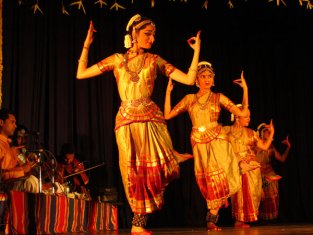
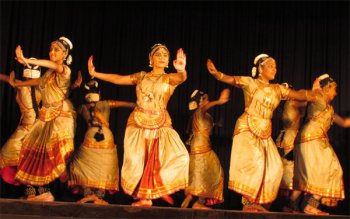
Natya Sankalpa
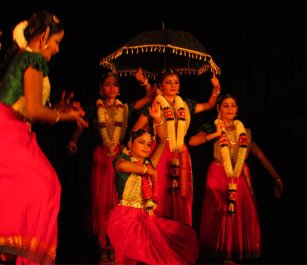
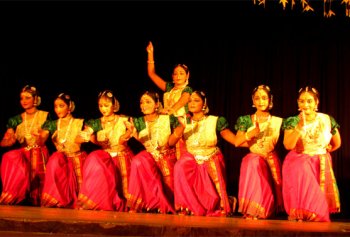
The final program was by students of Kalapradarshini, trained by Parvathi Ravi Ghantasala. Like the earlier group, the dancers first presented a Mallari in Gambiranattai, tisra triputa. In the pancharatna kriti “Jagadananda karaka” of Thyagaraja, Rama’s story was enacted by the 10 well trained and well coordinated dancers working in batches of five with smooth entries and exits, ending in a nice tableau. In the kirtanam “Vidai meethu bavani vandaan Vedapuri nathan” by Papanasam Sivan, the devotees describe Lord Shiva starting with a small procession scene. The program ended with the Katanakuthuhalam thillana of Dr. M Balamurali Krishna. It was a compact recital and dancers were all of uniform ability and coordinated well with each other, making for relaxed viewing. Soulful singing by Hariprasad, nattuvangam by Parvati Ravi Ghantasala, flute by Srinivasan, violin by Eswar Ramakrishnan and mridangam by Karthikeyan added to the dignity of the presentation. 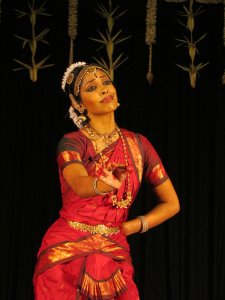 The final evening of the festival featured Nadhi Thekkek from San Francisco. She is a disciple of Sundara Swaminathan and Padmini Chari in the US, continuing further training from A. Lakshmanaswamy in Chennai. Her items for the evening were all choreographed by A Lakshman. She started with a pushpanjali in Simhendramadhyamam composed by Hariprasad followed by a sloka “Agajaanana” in dedication to Ganesha. The pada varnam “Innum en manam” in Charukesi composed by Lalgudi Jayaraman saw the heroine pining for Krishna to release her from her sorrows. Nadhi’s serene rendition was a contrast to the rather fast paced varnams seen earlier in the fest. The araimandi, the clearly defined movements and subtle facial expressions without overdoing the pathos and joys was a treat to watch. The distress of the heroine as she despairs of Krishna hearing her pleas to save her and the dawning joy when she hears the strains of the flute was beautifully depicted to Hariprasad’s soulful singing. In Patnam Subramanya Iyer’s “Samayamidhe ra ra,” Nadhi played the saucy heroine and she ended her dignified recital with a thillana in Maand by Lalgudi Jayaraman. Her wonderful accompanists were Hariprasad on vocal, A Lakshman on nattuvangam, G Vijayaraghavan on mridangam and N Sikhamani on violin. It was nice to see the mridangist and nattuvanar openly enjoying playing for the recital. Quite a few times, Nadhi looked like a taller version of Alarmel Valli, so strong was the facial resemblance in certain poses! “I am glad I got to perform in this festival. And that too with my teacher guiding me and being there on nattuvangam. It was a blessing. I also got to talk to my other teachers from the US before the program which was nice as well. Whether I am performing in a sabha or going to class daily, Chennai has a vibe that infuses a different energy into the way I dance. The people, the constant bustle, the temples, the sabhas, the shops… all of these aspects of Chennai put Bharatanatyam in vibrant context for me. I love it, and it is why I keep coming back,” says Nadhi. 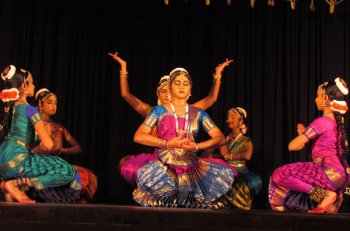

The finale of Natya Utsav was a group recital by 7 students of Kaladiksha trained by Meenakshi Chittaranjan. Attired in attractive costumes, they commenced with ‘Nartana Ganapathy’ composed by Srinivasan, followed by items on the lord of dance titled ‘Shambo Mahadeva’ giving scope for the dancers to show their prowess in nritta and storytelling. In the varnam ‘Karunai vadivamana kailaivaasa” composed by Pandanallur Srinivasa Pillai in ragam Revathy, the devotees praise Shiva as being made up of the 5 elements, the one who goes to the rescue of his devotees that included the Markandeya story and praise of the lord’s dance. “Tha thai enraaduvaar” in Sindhu Bhairavi composed by Gopalakrishna Bharati was the next joyous item showing the popular poses of Nataraja. The concluding item was Ponniah Pillai’s vibrant thillana in Shankarabharanam, “a raga known to be a favorite of Shiva.” The well trained dancers were beautifully coordinated and danced with supreme confidence despite some of them being very young. The dancers were 11 year old Kavya Ganesh who has been training for 4 years, 11 year old Duviksha who has been training for 5 years, 12 year old Divya Bharadwaj who has been training for 6 years, Arya Padmakumar, Sruti Umayal, Kavya Priya and Nivedita Muralidaran. Meenakshi Chittaranjan (nattuvangam), Gomathyvinayakam (vocal), Shaktivel Muruganandam (mridangam) and Kandadevi Vijayaraghavan (violin) supported the young dancers. It is indeed admirable that despite pressure of studies, these youngsters are diligently pursuing their interest in dance and doing a good job of it. Instead of the predominantly flat lighting, if there had been some more artistic lighting for the programs, it would have enhanced the presentations. Also, some decoration at the lobby would have lent more of a festive cheer. Lalitha Venkat is the content editor of narthaki.com |